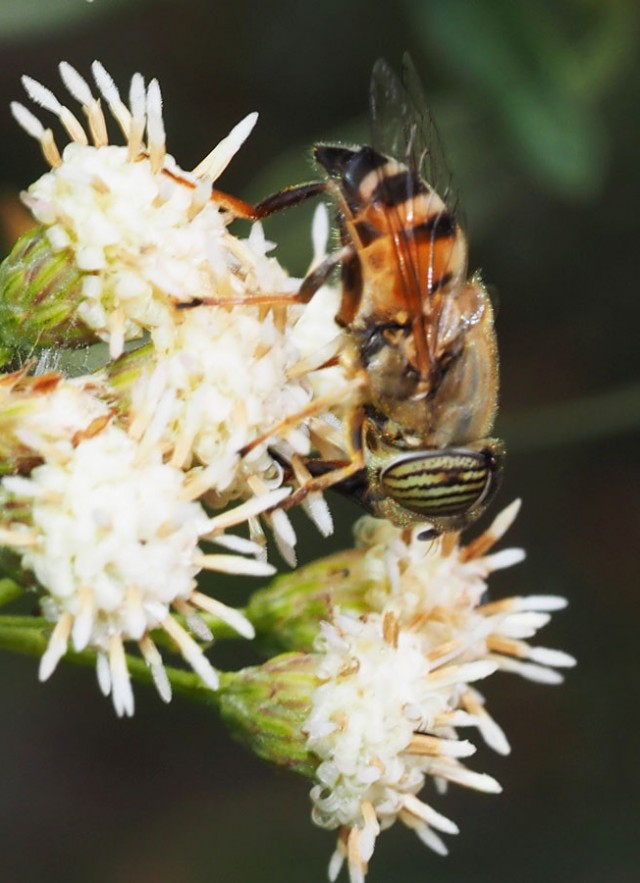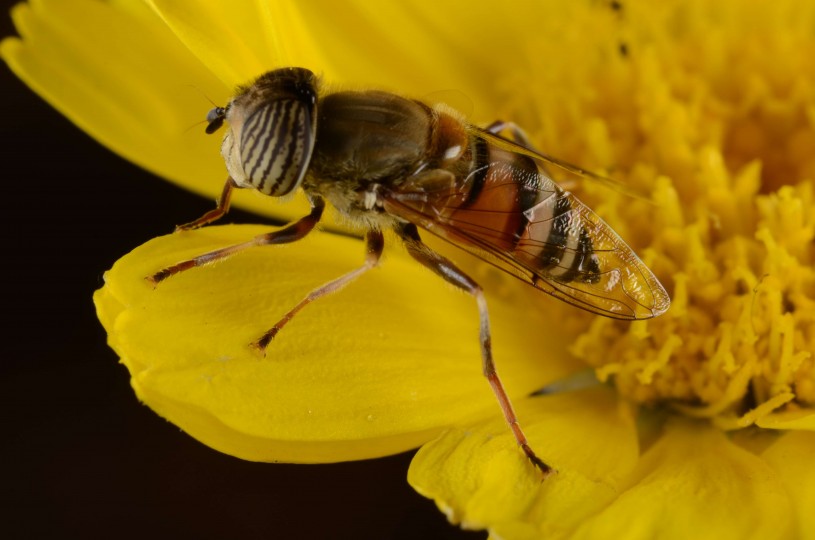BE ADVISED: On Saturday, April 26 and Sunday, April 27, nearby events at Exposition Park and the University of Southern California will impact traffic, parking, and wayfinding in the area. Please consider riding the Metro E (Expo) Line and exiting at USC/Expo station.
The Mesmerizing Eyes of Eristalinus Taeniopa
This week, we bring you a visual treat from BioSCAN's Principal Investigator, Curator of Entomology, and Photographer Extraordinaire, Dr. Brian Brown.

By Emily Hartop This week, we bring you a visual treat from BioSCAN's Principal Investigator, Curator of Entomology, and Photographer Extraordinaire, Dr. Brian Brown.
His beautiful photo (above) of Eristalinus taeniops was taken in the NHMLA's Nature Garden, home to BioSCAN Site #1. This species is commonly known as the Stripe-Eyed Flower Fly, from the family Syrphidae, commonly called Flower or Hover Flies from their habit of hovering hummingbird-style over flowers in search of nectar. Although syrphid flies are quite common in the BioSCAN traps, this particular species has not yet been captured by our project. Dr. Jim Hogue, also an entomologist and photographer as well as a BioSCAN site host, speculated that this fly is simply too strong a flier to be easily corralled into death by Malaise trap. The entomological equivalent of "The Ugly Ducking", the larvae of the stunning Stripe-Eyed Flower Flies are filth-dwelling Rat-Tailed Maggots. The "rat tail" is actually a telescopic breathing tube that allows larvae to mature in stagnant, and often polluted, water (and other moist substrates lacking in oxygen). The tube allows them to "snorkel" at the surface to breathe. Also on the list of this fly's unsavory larval habitats, rare cases of human intestinal myiasis — where larvae develop inside the human gut — have been documented for this group. The breathing tubes of the maggots, in this case, would be located in close proximity to their host's anus to allow them to breathe. Despite their distasteful beginnings, the Stripe-Eyed Flower Flies certainly turn out to be magnificent adults. Not only are they amazing honeybee mimics, but their striped eyes are absolutely hypnotizing. This pigmentation may serve an optical purpose, but more research must be done on this group before conclusions are to be made.

If you haven't seen the Stripe-Eyed Flower Fly buzzing around your yard, keep looking! The first California record for the species was in 2006 from Orange County. Three years later only a single specimen was found when Dr. Brown and Dr. Hogue worked on local Flower Flies for the booklet "Flower Flies of Los Angeles County". That single specimen was from Dr. Hogue's Eagle Rock backyard, which is now a BioSCAN site! Above, you can see another beautiful photograph of this species, this one taken by Dr. Hogue. Originally, Eristalinus taeniops was from southern Europe, Africa and the Middle East. Introduced species can sometimes create issues for native flora and fauna, but it doesn't appear that Eristalinus taeniops is creating any problems. We're glad, because it sure is a stunning addition to our Flower Fly fauna!